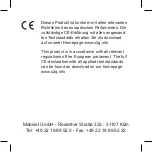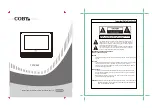
Not for
Reproduction
9
Operation
WARNING!
Engine exhaust contains carbon
monoxide, a poisonous gas that could kill you in
minutes. You cannot smell it, see it, or taste it.
Even if you do not smell exhaust fumes, you could still be
exposed to carbon monoxide gas.
• Extension cords running directly into the home increase
your risk of carbon monoxide poisoning through openings.
• If an extension cord running directly into the home is
used to power indoor items, the operator recognizes that
this increases the risk of CO poisoning to people inside
the home and assumes that risk.
4. Install a manual transfer switch as soon as possible
if generator will be used to provide home power
restoration.
5 Volt DC USB Ports
The combined maximum current available for the USB
ports is 2.1 Amps at 5 Volts. The USB port allows you to
recharge most USB powered devices with a USB charging
cable (not included).
NOTICE
For maximum output, use the bottom USB port.
NOTICE
For charging ITE (Information Technology
Equipment) only.
12 Volt DC Receptacle
The maximum current available for the 12 Volt DC
receptacle is 5 Amps. A DC circuit breaker protects this
receptacle from overloads. If an overload occurs, the circuit
breaker will trip (push button pops out). Wait a few minutes
and push the button in to reset the circuit breaker.
230 Volt AC, 15 Amp Receptacles
These receptacles are protected against overload by an
internal overload system.
Use receptacles to operate 230 Volt AC, single–phase, 50
Hz electrical loads requiring up to 2,800 watts (2.8 kW)
at 12.2 Amps of current. Use cord sets that are rated for
230 Volt AC loads at 15 Amps (or greater).
Output Indicator
The green LED output indicator light comes on when
the generator is operating normally. It indicates that the
generator is producing power at the receptacles.
Overload Alarm
The red LED overload alarm light comes on and cuts
power to the receptacles if you overload the generator. The
green output indicator light will also go off. If the generator
was overloaded, you must turn off and unplug all electrical
loads, press the “Reset” button on the generator control
panel and then plug in and restart electrical loads one at a
time to continue in normal operating mode.
Parallel Operation
Two Briggs & Stratton inverter generators can be run
in parallel with a Briggs & Stratton parallel operation kit
(optional equipment). When running in parallel, the total
output of power is shown in chart.
Models
Maximum Output
P2400 & P2400
3300 Watts
P2400 & P3400
4200 Watts
P3400 & P3400
5100 Watts
NOTICE
Total electrical load connected to the parallel kit
must not exceed the maximum output.
See the parallel operation kits instruction sheet for detailed
instructions on installation and operation of the connected
generators.
NOTICE
• Turn electrical loads OFF and disconnect from both
generators.
• The QPT switch must be in the same position on both
generators.
• Connect the parallel cables to both generators before
starting the engines. See instruction sheet supplied
with parallel kit.
• Start engine on one of the inverter generators
according to
Generator Start Up
.
• Once the green LED output indicator light on the first
generators is steady, start second generator.
• Connect and turn on electrical loads to the parallel
panel receptacles.
• DO NOT disconnect parallel cables after engines have
been started.
• Shut down engines as described in
Generator
Shutdown
.
QPT (QUIET POWER TECHNOLOGY)
This feature is designed to greatly improve fuel economy.
When QPT is on, engine speed increases as loads are
connected, and decreases as loads are removed.
When QPT is off, engine will run at full governed speed.
www.caravansplus.com.au


































